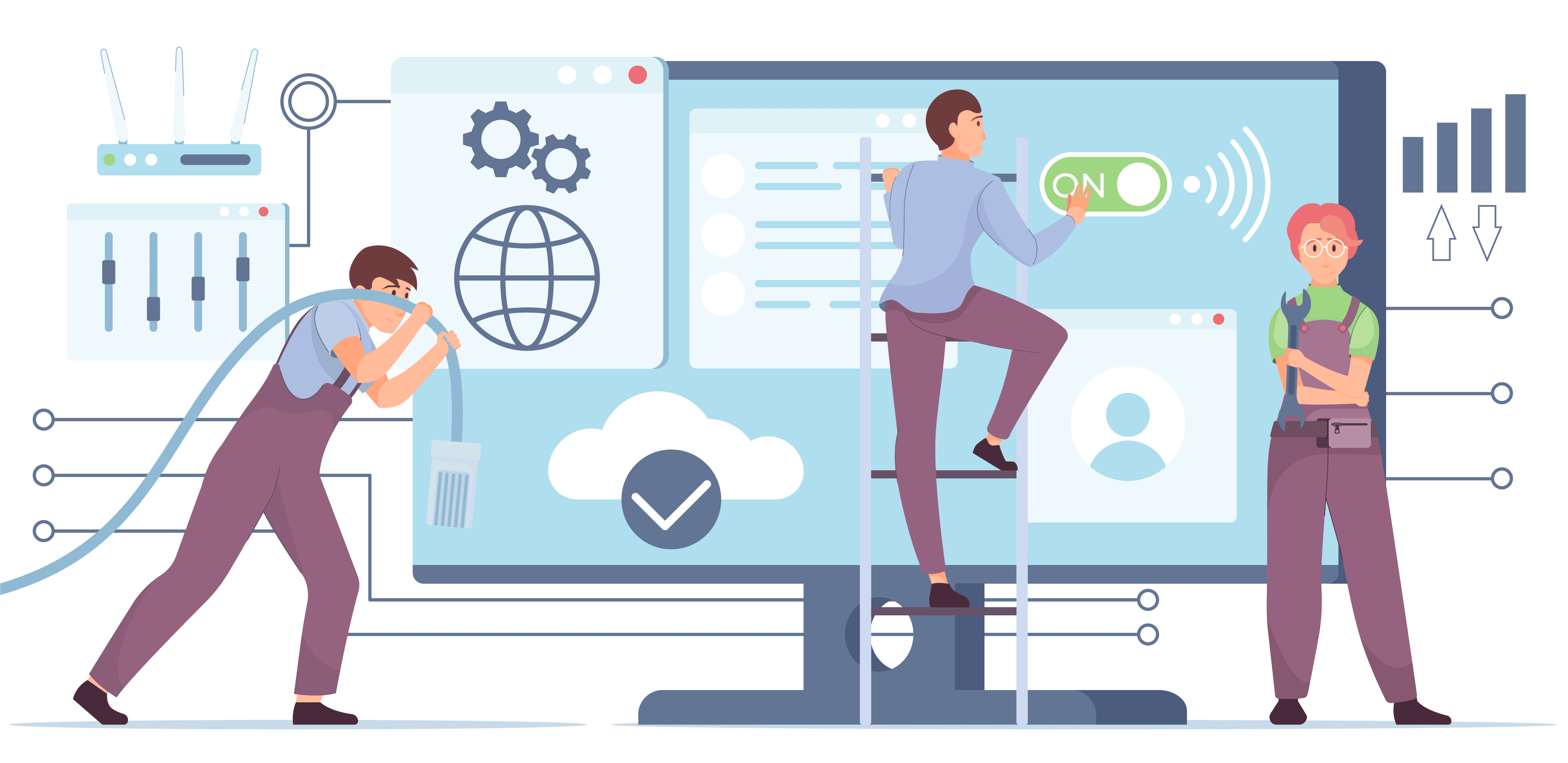Service Desk Management: The Hidden Skills That Make Great Tech Leaders

Photo by freepik @ freepik
Most people assume service desk management is about fixing computers and closing tickets. In reality, it’s far more dynamic. As a Service Desk Manager, you’re not just handling help requests—you’re leading one of the most critical operational hubs in any organisation. The service desk touches every department, manages countless workflows, and serves as the frontline for both technical support and customer satisfaction.
Your work spans multiple teams, time zones, and challenges. You’re responsible for keeping systems running while also ensuring the people using them feel heard, supported, and valued. That means balancing technical acumen with leadership, communication, and strategic thinking.
The modern service desk leader needs to be fluent in two languages: technology and human behaviour. You must understand how to optimise complex IT processes while also motivating your team, managing workloads, and navigating the psychology of frustrated users. And it doesn’t stop there as your role increasingly involves preventing issues before they arise, aligning support operations with broader business objectives, and demonstrating measurable value to the organisation.
The Evolution - From Help Desk Manager to Tech Leader
The service desk manager role has transformed dramatically over the past few decades. What started as a purely technical support function now demands sophisticated leadership capabilities and strategic vision.
How the role has changed over the years
Twenty years ago, service desk managers spent their days troubleshooting technical issues and managing basic ticket queues. Your main job was simple: fix problems fast and keep business disruption to a minimum. Today's reality looks completely different.
The shift from "help desk" to "service desk" marked the first significant evolution. ITIL (Information Technology Infrastructure Library) played a massive role in this change. As one expert notes, "ITIL has played an important role in the evolution of the IT help desk through the growth in IT help desk tool use". This framework didn't just standardise processes – it introduced concepts like service request management and change management that expanded what traditional help desk operations could accomplish.
Technology advancements created another significant shift. Modern service desk managers need proficiency with sophisticated service management software, knowledge bases, and analytics tools. These technological changes fundamentally altered team operations, moving from reactive problem-solving to proactive service delivery.
The career progression path has also become more structured. Most professionals start at the help desk, advance to system administrator positions where they "expand on the experience gained at the help desk", then eventually move into IT management roles that build on both technical and practical experience.

This may interest you: A Business Leader’s Guide To Seeking Managed IT Services
Why leadership now matters more than ever
Service desk leadership has become the defining factor that separates average support teams from exceptional ones. The numbers tell the story: 44% of business leaders report dissatisfaction with their employees' work, with 70% attributing this to poor communication skills. This explains why soft skills now rival technical capabilities in importance.
Leadership quality directly impacts team performance and retention. Employees who rate their manager's performance poorly are four times more likely to be searching for a new job. Even more concerning, 55% of IT professionals believe their profession negatively affects their personal well-being, with only 25% feeling valued by management.
Strong service desk leaders now must:
- Develop empathetic leadership and promote open communication
- Create growth opportunities within their teams
- Understand the nuances of running a call centre
- Balance technical expertise with people management
- Align IT support with broader business objectives
Since service desk operations typically span multiple teams, locations, and shifts, effective management requires exceptional communication and delegation skills. Leaders must cultivate environments where team members feel empowered to share ideas and take ownership of their work.
The most significant evolution? Service desk management now extends beyond technical problem-solving to strategic value delivery. As one industry expert explains, service desks are moving toward "value demonstration – with IT help desks required to look beyond what they do, to see and report on what they achieve through what they do". This shift toward measuring business impact rather than just technical metrics represents perhaps the most significant change in the role.
The bottom line is clear: modern service desk managers must be both technically savvy and people-oriented, focused on employee experience and engagement, not just ticket resolution. This balance of skills transforms good managers into exceptional tech leaders.
Core Service Desk Management Roles and Responsibilities
Service desk managers wear multiple hats, and understanding these core functions helps establish realistic expectations for this demanding role.
Team supervision and performance reviews
Team leadership forms the backbone of effective service desk management. You're supervising help desk staff, providing training, mentorship, and coaching to develop their skills. Regular performance reviews become essential for discussing achievements, spotting improvement opportunities, and setting annual goals.
Your team supervision responsibilities include:
- Meeting regularly with direct reports to discuss workload and performance
- Setting priorities and managing day-to-day tasks to meet service level agreements
- Participating in hiring and firing decisions, including interviewing candidates
- Training new employees on company policies and procedures
- Following up on negative customer satisfaction scores to improve service quality
Here's the thing about performance management – it requires both data-driven analysis and genuine people skills. You need to set clear performance indicators (KPIs), benchmark staff performance, and share documented reviews with higher management.
Incident and request management
Service desk operations centre around handling incidents and service requests efficiently. You oversee the entire incident management process, ensuring timely responses to support tickets and appropriate escalation when needed.
The incident management hierarchy flows through multiple tiers. Tier 1 service desk handles common issues like password resets, while more complex problems escalate to Tier 2 and specialist Tier 3 teams. As a service desk manager, you coordinate these tiers, monitor incident resolution times, and ensure compliance with service level agreements.
Effective incident management requires implementing proper protocols and maintaining communication with related departments. The challenge is balancing quick resolution with thorough documentation to prevent recurring issues.
Process improvement and documentation
Process improvement stands as one of the most significant yet often overlooked responsibilities. You must regularly analyse workflows and performance metrics to identify inefficiencies and implement strategies for streamlining operations.
This responsibility covers:
- Developing and documenting help desk processes
- Conducting regular audits to ensure compliance with industry standards
- Implementing management frameworks like ITIL for operational efficiency
- Creating and maintaining knowledge bases
The first thing you need to understand about process improvement is that it's not a one-time project. It's an ongoing commitment. You must foster a culture where teams constantly seek better ways to deliver services and support organisational goals.
Budgeting and resource planning
Resource management enables tracking resource loads and deploying the right people to the right tasks. You need to understand and manage the operations budget while allocating resources effectively.
Effective resource planning involves monitoring technician workloads (identifying who is over-utilised, optimally utilised, or under-utilised), checking availability for specific periods, and planning for long-term projects. This strategic approach prevents missed deadlines caused by improper resource allocation.
Budgeting extends beyond simply controlling costs. It aligns technology investments with business goals. Through the budgeting process, you can identify and reallocate non-essential expenses to higher-priority investments. This ensures that limited resources deliver maximum value to the organisation.
These four core responsibilities form the foundation upon which successful service desk managers build their teams and deliver exceptional IT support services.

The 8 Hidden Skills that Define Great Service Desk Managers
Technical expertise and operational knowledge will get you hired. These eight skills will make you exceptional.
Most service desk management guides focus on processes, tools, and metrics. While those matters are important, the real differentiators lie in subtle competencies that separate merely competent managers from outstanding tech leaders.
1. Active listening and user empathy
Top service desk managers understand user concerns before proposing solutions. Active listening means absorbing facts shared by colleagues and reflecting back acknowledgement that concerns were heard and understood. This approach reduces miscommunication, eases potential conflict, and helps managers appear more in control during high-pressure situations.
The most effective managers know that frustrated users aren't attacking the technology – they're expressing genuine business pain. When you listen first, you solve the right problems.
2. Data-driven decision making
Great managers analyse performance metrics to identify trends and foster a culture of accountability. Organisations using analytics can boost customer satisfaction by 10-15%, offering a competitive edge. Through data analytics, managers can illuminate patterns contributing to bottlenecks, such as recurring delays or excessive handoffs between teams.
Data tells stories that intuition misses. The key is knowing which metrics actually matter and how to act on them.
3. Delegation and workload balancing
Strategic task distribution prevents burnout and maximises productivity. Effective delegation requires equitable distribution based on capabilities rather than simply dividing work evenly. Through capacity visualisation tools, managers can gain at-a-glance views of current workloads, making imbalances immediately apparent and actionable.
The goal isn't to keep everyone busy – it's to keep everyone effective.
4. Cross-functional collaboration
Breaking down departmental silos enables diverse perspectives that spur innovation. Cross-functional collaboration yields increased momentum by involving multiple viewpoints. When people with different areas of expertise collaborate, they educate one another—combining unique perspectives creates better solutions to problems.
Service desks don't operate in isolation. The best managers build bridges, not walls.
5. Change management readiness
Despite its reputation for bureaucracy, change management can be a positive practice when properly implemented. Risk assessment forms the heart of effective change enablement, ensuring consistent evaluation of potential impacts. Maintaining centralised change calendars helps managers avoid scheduling conflicts that could disrupt operations.
Change is inevitable in IT. Skilled managers make it predictable.
6. Continuous learning and adaptability
The shift from the knowledge era to continuous learning requires hyperadaptability. Double-loop learning goes beyond addressing immediate problems to understand root causes—circumventing issues before they occur. Successful managers transfer knowledge by linking new concepts to existing ones, frequently repeating information, and teaching others.
What worked last year might fail this year. Adaptable managers stay ahead of the curve.
7. Conflict de-escalation
Resolving user conflicts requires a calm approach that focuses on solutions. Once someone feels understood, the brain releases oxytocin (the 'bonding' hormone), which reduces stress and helps people work together. Tactical empathy involves recognising the other side's perspective even when you disagree—helping maintain control while making users feel heard.
Angry users become collaborative partners when you master this skill.
8. Vision for scalable support systems
Forward-thinking managers create resilient frameworks supporting growth without overextension. This involves thoroughly assessing system capacity across infrastructure, processes, and human resources. Establishing collaborative tools facilitates real-time interaction and reduces information silos that often hinder scalability.
Building for today is management. Building for tomorrow is leadership.
Tools and Technologies Every Manager Should Master
The right technology stack can make or break your service desk operations. Pick the wrong tool, and you'll spend more time fighting it than helping users. Pick right, and your team becomes unstoppable.
Service desk management software essentials
Most service desk platforms promise the world. Few deliver on those promises.
Modern solutions like Zendesk, ServiceNow, and Freshservice offer unified workspaces where agents can handle requests across multiple channels, including chat, email, and phone. The key feature you need? AI-powered ticket routing that ensures questions always reach the appropriate team member. Organisations using analytics within their service desk operations can increase customer satisfaction by 10-15%.
Here's what matters when selecting a platform: Does it reduce the clicks needed to resolve common issues? Can your team customise workflows without calling IT support? Does it integrate with your existing systems without requiring expensive middleware?
Everything else is just marketing fluff.
Remote support and monitoring tools
Remote support capabilities aren't optional anymore. They're survival tools.
Tools like BeyondTrust Remote Support enable technicians to connect to users' devices regardless of location—without requiring VPN access. Over 70% of organisations using robust remote support solutions report reduced incident handling times, while 85% experience improved first-call resolutions.
Look for solutions offering secure attended and unattended access options. Your team needs to troubleshoot issues even when users aren't present. The ability to schedule maintenance during off-hours can prevent countless Monday morning disasters.

Read more: Understanding Remote Management Systems: A Comprehensive Guide
Knowledge base and documentation platforms
A well-maintained knowledge base serves dual purposes: it empowers users to solve problems independently and equips support agents with consistent troubleshooting information. Effective knowledge platforms organise content into scannable formats with robust search functionality.
Your knowledge base needs these components:
- Guides and troubleshooting documentation
- Frequently asked questions (FAQ) pages
- AI-powered content suggestions
- User feedback mechanisms
Teams implementing self-service knowledge bases see significant ticket deflection, as users can find answers without submitting formal requests. But here's the catch: outdated knowledge bases create more problems than they solve. Assign ownership and update schedules, or don't bother building one.
Analytics and reporting dashboards
Data without action is just expensive digital clutter.
ServiceDesk Plus offers over 200 predefined reports and 80+ KPIs to measure team performance. Effective dashboards provide visualisation options, including pie charts, bar charts, and time series displays, to make statistical information more digestible. Focus on metrics that matter: resolution times, SLA compliance, backlog analysis, and user satisfaction scores.
The right dashboard transforms raw service desk data into actionable insights that help you identify bottlenecks, forecast trends, and optimise workflows. This visibility allows you to make tactical decisions that improve operational efficiency while demonstrating IT's value to the broader organisation.
Most importantly, your dashboard should answer this question within 30 seconds: "What needs my immediate attention today?"
Best practices for service desk management in 2025
Successful service desk operations don't happen by accident. They require strategic implementation of practices that work—not just the ones that sound good in meetings.
Aligning IT support with business goals
Here's the uncomfortable truth: most service desk managers still think their job is just fixing things. IT is no longer just a support function but an integral component of business strategy. The sooner you understand this, the better.
For proper alignment, IT leadership should participate actively in high-level business discussions. Establish regular, structured communication between IT and business leaders through strategy sessions where both sides discuss goals, challenges, and opportunities.
The key is positioning your service desk as a business enabler, not a cost centre. When executives see how your team directly contributes to organisational objectives, everything changes.
Possibility of external partners
While many service desks operate entirely in-house, some organisations benefit from strategic partnerships with outside providers. For example, working with an MSP outsourcing company can provide additional capacity during high-demand periods or fill specialised skill gaps without expanding the permanent team. This approach can also offer access to advanced tools and processes that may be cost-prohibitive to implement internally. The key is ensuring that external resources align with your service standards and integrate seamlessly with existing workflows.
Creating a culture of accountability
Most managers get accountability wrong. They think it's about catching people making mistakes. It's not.
Proper accountability fosters collaboration and team cohesion. Instead of using performance monitoring as a policing tool, implement transparent dashboards that give agents direct visibility into their KPIs. This approach shifts the focus from catching mistakes to driving trust and growth.
When accountability is done right, it creates psychological safety where team members feel free to discuss challenges without fear of punishment. Studies show that psychologically safe teams demonstrate enhanced learning behaviours and overall effectiveness. The result? Highly engaged teams outperform peers by more than 200%.
Encouraging self-service and automation
Self-service technology empowers users to solve straightforward issues independently. The implementation strategy matters:
- Keep interfaces simple and uncluttered to prevent overwhelming users
- Develop knowledge bases with regularly updated articles, FAQs, and troubleshooting guides
- Use automation for routine processes like ticket creation and routing
- Monitor success metrics, including ticket volume reduction and resolution times
The goal isn't to replace human support—it's to free your team for complex problems that require their expertise.

Maintaining compliance and security standards
Your service desk functions as the first line of defence against cyber threats. This responsibility goes far beyond password resets.
Implement robust security measures, including strict password policies, multi-factor authentication, and data protection protocols. Regular training helps staff identify social engineering attacks that could jeopardise IT infrastructure.
Don't stop at general security standards. Identify applicable industry regulations beyond GDPR and ISO certifications. Conduct independent software audits to identify compliance weaknesses, then develop plans to address them.
Remember: Compliance failures don't just hurt your organisation—they can end careers.
Conclusion
Service desk management is no longer a purely technical discipline—it’s a leadership role with direct influence over organisational performance. The best managers combine technical mastery with emotional intelligence, strategic vision, and a relentless focus on value delivery. They don’t just resolve incidents; they build teams, streamline processes, and shape how the business experiences IT as a whole.
The hidden skills aren’t optional add-ons; they’re the foundation of modern service desk leadership. Without them, even the most sophisticated tools won’t produce lasting results.
Ultimately, the difference between a functional service desk and a high-performing one comes down to leadership mindset. Great managers see every ticket, conversation, and process as part of a larger ecosystem. They align their operations with business goals, champion continuous improvement, and cultivate an environment where both users and team members feel supported.
Leaderonomics.com is an advertisement-free website. Your continuous support and trust in us allow us to curate, deliver, and maintain our website. When you support us, you enable millions to continue reading for free on our website. Will you give it today? Click here to support us.
Leadership
Tags: Abundance Mindset, Alignment & Clarity, Building Functional Competencies, Business Management, Digital, Data, Consultant Corner, Competence, Executing Leadership
Content manager and SEO specialist by day and content writer by night, Carl Fisher is dedicated to bringing knowledge, information, and advice to those who need it. His "speciality areas" include digital marketing, web development, technology, magical realism and sci-fi literature. With more than 10 years in the digital marketing industry, he works at Tuna Creations- a growth company that primarily works with product development teams and tech startups struggling to grow and monetise their user base.





